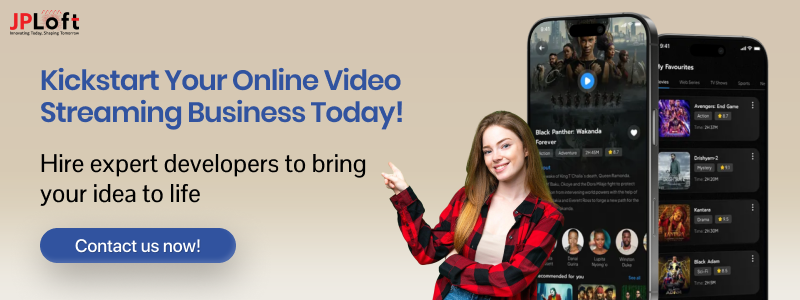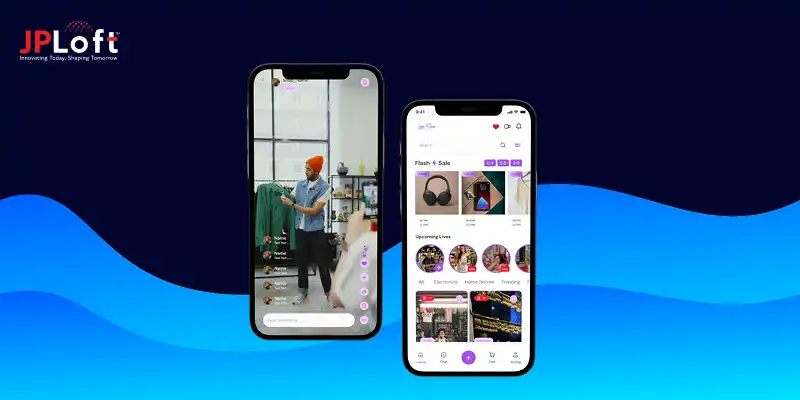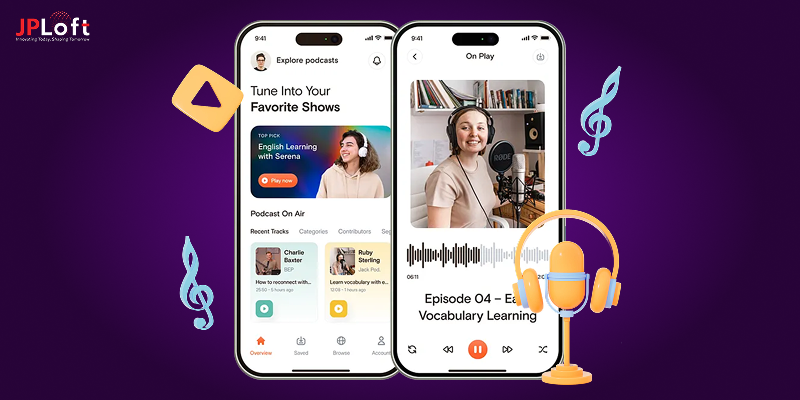Starting an online video streaming business is an exciting opportunity to tap into the rapidly growing digital content market.
With more people consuming video on demand and live streams daily, launching a streaming platform can connect you with a wide audience.
Many people face some challenges when starting out without proper guidance; they often turn directly to large companies for help.
Whether you aim to share entertainment, education, or niche content, understanding your target viewers and delivering a seamless experience are key to building a profitable streaming business.
As this guide will lead you from A to Z, how to start an online video streaming business?
And how to successfully grow it in today's competitive digital landscape?
What Is a Video Streaming Business?
A video streaming app business delivers video content to users over the internet in real time, allowing viewers to watch without downloading the entire file.
To set up a video streaming business that supports both on-demand and live streaming services, focus on catering to entertainment, education, sports, and more to attract a wide audience.
Most businesses in this industry design their platforms to allow users easy access to movies, tutorials, and various other types of content.
Here are some recent statistics showcasing how video streaming apps are performing in the market and why investors are increasingly attracted to investing in this business.
Market Size and Statistics of Video Streaming Apps
The market size largely depends on the number of investors involved, as they play a key role in driving growth and influencing overall market capitalization.
-
Revenue in the video streaming market is projected to grow steadily, with an annual growth rate (CAGR) of 6.9% between 2025 and 2029.
-
A report showcases that by 2029, the market is expected to reach a massive $155.51 billion.
-
The United States is set to lead the way, generating the highest revenue worldwide, around $47.89 billion by 2025.
-
When it comes to users, the global video streaming audience is expected to hit 1.7 billion by 2029.
-
User penetration is also on the rise, moving from 19.3% in 2025 to an estimated 21.7% by 2029.
As the video streaming business set up continues to rise each day, the overall market size is expected to grow steadily, creating more opportunities for businesses to expand and thrive.
Now that we've reviewed the key business stats, let's explore the benefits enjoyed by owners who are actively running their video streaming businesses in the market.
Benefits of Starting a Video Streaming Business
Every business comes with its own set of advantages and disadvantages, but here, we’ll focus on the key benefits of running a video streaming business.
Here are some key advantages that can help your business grow and succeed.
A] Global Reach
To create a video streaming app with a strong global presence, it’s crucial to offer content that’s accessible anytime, anywhere.
When users from different regions can effortlessly access your platform, your business expands its reach and strengthens its market position.
A wide global reach breaks down geographical barriers, attracting more users worldwide.
This increased accessibility boosts engagement, grows your user base, and unlocks diverse revenue opportunities.
B] Multiple Monetization Options
One of the major advantages of a video streaming business is the variety of monetization models available.
To start an online video streaming business, you can try different monetization strategies to keep your users engaged.
This flexibility allows you to tailor your revenue model to suit your audience and maximize profitability.
By implementing these approaches, you can attract a larger audience and maximize profits effectively on your platform.
C] Potential for Cross-Promotion
Cross-promotion offers a powerful opportunity to expand your video streaming business by leveraging related products or services.
By strategically cross-promoting, you build brand awareness and encourage users to explore more offerings with advanced features, ultimately boosting customer loyalty and maximizing the overall profitability of your streaming business.
When you create an app that integrates features offering additional services to users, it can significantly boost your sales.
These features, often powered by virtual AI, enhance user experience and engagement, driving increased revenue and customer satisfaction over time.
D] Technological Advancements
Technological advancements play a key role when you start a streaming service business.
Innovations like AI-driven recommendations, 4K and HDR video quality, cloud storage, and real-time analytics enhance user experience and platform performance.
These technologies not only improve streaming quality but also help in personalizing content, optimizing operations, and staying competitive in the market.
Now that you're familiar with the benefits of owning a video streaming app, it's time to take the next big step, transforming your idea into a fully functional and successful platform.
Let’s dive into the process!
How to Turn Your Idea into a Market-Ready Product?
Turning an idea into a market-ready product involves planning, development, and strategic execution.
It’s all about refining your concept, building the right solution, and preparing it for real-world success.
Start a business of video streaming to accelerate your growth and gain deeper insights into delivering your product effectively to users.
It’s a powerful way to scale while understanding audience needs.
Here are some key Strategies to Effectively Boost Your Product in the Market:
1. Conceptualizing the Idea
Identify your niche by selecting the type of content you want to offer, such as movies, live events, sports, or educational programs.
Next, define your target audience by considering factors like age, interests, and geographic location.
Understanding these elements is crucial when choosing the right video streaming monetization model, as it helps tailor your revenue strategy to suit your audience’s preferences and maximize engagement and profitability.
2. Platform Planning
When planning your platform, decide whether it will be available on mobile, web, or both to reach your target users effectively.
Choosing a streamlined model that fits perfectly with your business goals, whether subscription-based, advertisement-based, or pay-per-view crucial.
Understanding these factors is essential for estimating the cost to create an app and ensuring your platform delivers a seamless user experience while maximizing revenue potential.
3. Technical Architecture
When learning how to start an online video streaming business, focusing on the right technical architecture is key.
Opt for scalable backend infrastructure using cloud services like AWS or Google Cloud.
Choose reliable streaming protocols such as HLS or DASH to provide smooth playback.
Plus, integrating a Content Delivery Network (CDN) helps reduce latency and buffering, ensuring your viewers enjoy a seamless and high-quality streaming experience every time.
5. Platform Development
During the development phase, prioritizing designing a user-friendly and intuitive interface for both mobile and web platforms.
To further elevate the user experience, leverage AI and machine learning for personalized content recommendations and smarter search functionality.
Addressing these elements effectively helps overcome common video streaming app development challenges and sets your platform up for success.
6. Payment Gateway Integration
Integrating a reliable payment gateway is essential for a seamless user experience in your streaming app.
By offering popular options like PayPal and Stripe, you ensure secure and smooth payment processing for subscriptions, rentals, or pay-per-view purchases.
This not only builds trust with users but also simplifies transactions, reduces cart abandonment.
7. Security Features
When you launch a video streaming app, robust security features are crucial.
Implement Digital Rights Management (DRM) to protect your valuable content from unauthorized access and piracy.
Additionally, prioritize user data privacy by using security protocols such as SSL and advanced encryption methods.
These security measures ensure that users’ personal information remains safe, building trust and safeguarding your platform against potential security threats.
8. Testing
To ensure a flawless user experience, thorough app testing is essential during the development process.
This involves evaluating the platform’s ability to perform under heavy traffic without lag or downtime.
Additionally, it's crucial to verify that the app functions seamlessly across various devices, including smartphones, smart TVs, and laptops, to ensure broad compatibility and consistent performance.
9. Launch and Marketing
To build excitement ahead of your app's release, roll out a compelling pre-launch campaign.
Share sneak peeks, send out targeted email newsletters, and post engaging content on social media to spark curiosity and draw early attention.
Collaborate with influencers or content creators to amplify your reach and generate buzz.
These efforts create strong momentum, increase visibility, and lay the foundation for a successful launch of a video streaming business.
10. Ongoing Maintenance and Upgrades
Ongoing App maintenance services are essential to keep your car rental app running smoothly and securely.
Regular updates ensure compatibility with the latest devices and operating systems, while also improving performance and fixing bugs.
Adding new features based on user feedback enhances the overall experience and keeps your app competitive in the market.
Investing in continuous improvements ensures long-term success, user satisfaction, and the scalability of your platform.
Top Features That Make Businesses Stand Out
To start an online video streaming business, incorporating key functionalities is essential to deliver a smooth and engaging user experience that keeps viewers comfortable and coming back for more.
Here are key video streaming app features that can make your business a hit to include:
► Content Recommendation
Personalized Recommendations are essential for enhancing user engagement and satisfaction on any video streaming platform.
By analyzing viewer behavior, watch history, and preferences, your app can deliver tailored content suggestions that keep users hooked and encourage longer viewing sessions.
If you’re wondering how to start an online video streaming business, integrating AI-driven personalized recommendations is a powerful strategy to boost user retention.
This unique feature helps create a unique, customized experience that sets your platform apart from competitors and drives steady revenue growth.
► Offline Viewing
Offline Viewing allows users to download videos and watch them without an internet connection, providing flexibility and convenience.
This feature is especially valuable for users who travel or have limited internet access.
By enabling offline viewing, streaming platforms can improve user experience and reduce churn.
To start an online video streaming business, you must have these features that will help you attract and retain subscribers by offering content accessibility anytime and anywhere.
► Content Upload & Management
Content upload and management is a core feature that allows creators or admins to easily add, organize, and control video content on the platform.
To start and launch a video streaming business successfully, you need an efficient content management system to streamline operations.
It also helps maintain content quality, ensure timely updates, and provide users with a consistent viewing experience.
► Social Sharing & Interaction
Starting an online video streaming business requires incorporating social sharing and interaction features that allow users to share content across the platform and engage through comments and discussions.
These tools not only boost user engagement but also create a strong sense of community.
They are vital for enhancing visibility and cultivating user loyalty in today’s competitive streaming market.
Implementing these features effectively can set your platform apart and encourage long-term user retention.
► User Profile & Parental Controls
Allow users to create personalized profiles tailored to their viewing preferences.
With built-in parental controls, families can manage and restrict access to age-inappropriate content, ensuring a safe and suitable streaming experience for younger viewers.
These features not only enhance user satisfaction but also build trust among parents, making your video streaming app more family-friendly and appealing to a wider audience.
► Live Streaming
Live streaming allows real-time broadcasting of events, shows, or videos to users, enhancing user engagement and improving app retention.
Video streaming business setup requires consistent content delivery that enables viewers to participate through chats or reactions.
This feature is essential for creating dynamic experiences and attracting larger audiences in the competitive video streaming industry.
► Customer Support Integration
Customer support integration is vital for providing timely assistance and resolving user issues effectively.
It includes features like live chat, help centres, and ticketing systems, ensuring users receive quick responses to their queries.
This not only improves customer satisfaction but also builds trust and loyalty.
Efficient support is essential for maintaining a positive reputation and long-term success on any streaming platform.
► Multi-Language Support
Multi-language support is essential for reaching a broader, global audience by offering your product or app in multiple languages.
This feature enhances accessibility, making users from different regions feel valued and comfortable using your platform.
It also increases market potential and helps you compete internationally.
Implementing this feature can enhance the user experience, boost engagement, and increase adoption rates by overcoming language barriers.
How Much Does It Cost to Start an Online Video Streaming Business?
If you’re wondering how much it costs to start an online video streaming business, it largely depends on several factors, such as app complexity, features, and the development team.
The cost to start a video streaming business can vary widely, typically ranging from $30,000 to $350,000, depending on the scope and scale.
Understanding the overall cost to create a video streaming app upfront is crucial for budgeting effectively and ensuring your streaming business launches successfully with the right resources in place.
Careful planning and research will help you make informed decisions and avoid unexpected costs down the line.
Here is a table explaining well about the overall cost to turn your idea into a product:
|
Aspect |
Cost Range |
Description |
|
Basic Video Streaming App |
$30,000 - $50,000 |
Includes basic features like user registration, video upload, and playback with limited customization and functionality. |
|
Mid-Range Streaming App |
$50,000 - $150,000 |
Includes advanced features like content management, payment integration, user interaction (chat/comments), and multi-device support. |
|
Premium Streaming App |
$150,000 - $350,000 |
Includes features such as live streaming, social sharing, AI-based recommendations, multi-language support, and complex user interface design. |
How to Make Money From Your Online Video Streaming Business?
Monetizing your online video streaming business is essential for long-term growth and sustainability.
With the right strategies, you can turn content into consistent revenue.
From subscriptions to advertisements and pay-per-view models, there are multiple ways to generate income while delivering value to your audience and scaling your streaming platform.
Here are some key points to guide you in developing effective strategies for building a video streaming app.
1. Subscription Model
The subscription video on demand (SVOD) model allows users to pay a recurring fee monthly, quarterly, or annually for unlimited access to your content library.
This steady revenue stream helps maintain financial stability while offering viewers continuous value.
If you plan to start like Netflix-like video streaming business, SVOD is a proven and highly effective monetization strategy.
2. Advertisement Revenue
Advertisement-based Video on Demand (AVOD) allows users to access content for free while generating revenue through ads placed before, during, or after videos.
This model works well for attracting a broad audience without subscription barriers.
As part of current video streaming app development trends, AVOD is gaining popularity for its scalability and advertiser appeal.
It’s especially effective for platforms targeting emerging markets or budget-conscious viewers.
3. Pay-Per-View
The pay-per-view or transactional video on demand (TVOD) model lets users purchase or rent individual pieces of content without a subscription.
To start an online video streaming business, you need to offer exclusive events and premium content to keep your users engaged.
Providing unique and high-quality content helps attract a loyal audience and drives consistent revenue growth.
4. Freemium Model
The freemium model offers basic content or features for free while charging users for premium access, exclusive content, or advanced functionalities.
It’s a powerful way to attract a large user base initially and convert loyal viewers into paying customers over time.
This model balances accessibility and profitability, making it ideal for growing a video streaming platform gradually and sustainably.
5. Sponsorships & Brand Collaborations
Sponsorships and brand collaborations generate revenue by partnering with companies to feature sponsored content, product placements, or co-branded campaigns.
These partnerships boost brand visibility and credibility while providing engaging content for viewers.
This approach helps diversify income streams and strengthens your platform’s presence in the competitive streaming market.
How JPLoft Can Help You Build a Successful Video Streaming Platform?
JPLoft offers expert guidance to build powerful, user-friendly streaming platforms that meet industry standards and exceed user expectations.
From concept and design through development and deployment, their skilled team integrates essential features like adaptive streaming, secure payment gateways, and social sharing to enhance engagement and retention.
By leveraging the latest technologies and current development trends, JPLoft delivers scalable, secure, and high-performance solutions tailored to your business needs.
Choosing the best video streaming app development company means partnering with a dedicated expert committed to turning your streaming business idea into a successful reality.
Their ongoing support and maintenance services ensure your platform remains up-to-date and competitive in the rapidly evolving streaming market.
Conclusion
In conclusion, launching a successful video streaming business requires careful planning, the right technology, and a clear monetization strategy.
Incorporating essential features like adaptive streaming, secure payments, social sharing, and live streaming enhances user engagement and retention.
Staying updated with the latest development trends ensures your platform remains competitive and scalable.
Choosing the right business model, whether subscription-based, ad-supported, or pay-per-view, can significantly impact your revenue streams.
By focusing on these key elements, you can create a dynamic and profitable video streaming platform that meets user expectations and thrives in a competitive market.
FAQs
Offer high-quality content, a user-friendly interface, personalized recommendations, social sharing features, and responsive customer support.
You need to secure content licenses, comply with copyright laws, protect user data, and follow regional regulations such as GDPR or COPPA.
Implement DRM (Digital Rights Management), secure payment gateways, encrypted data transfer, and regular security audits to protect your content and user data.
Common models include subscription (SVOD), advertisement-based (AVOD), pay-per-view (TVOD), freemium, and sponsorships or brand collaborations.
Adaptive bitrate streaming automatically adjusts video quality based on the user’s internet speed, ensuring smooth playback without buffering or interruptions.












Share this blog